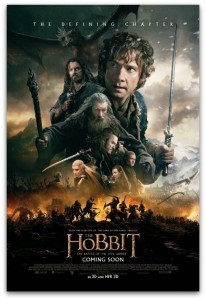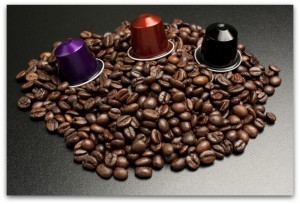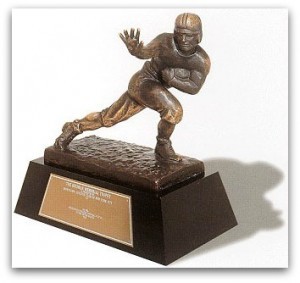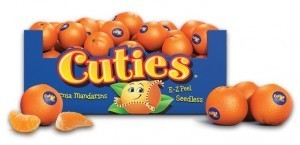Bathroom Readers' Institute's Blog, page 122
December 18, 2014
6 Random Trivia Facts About ‘The Hobbit’
The third and final part of the fantasy trilogy is in theaters now. Here’s some random trivia facts about the source novels and the movies, too.
 The Hobbit author J.R.R. Tolkien made up the word “hobbit,” which proved difficult for foreign-language publishers to translate. The Swedish edition of the book was called Hompen. In Portuguese, it was titled O Gnomo, or “The Gnome.” In the manufactured “universal” language of Esperanto, the novel is titled La Hobito.
The Hobbit author J.R.R. Tolkien made up the word “hobbit,” which proved difficult for foreign-language publishers to translate. The Swedish edition of the book was called Hompen. In Portuguese, it was titled O Gnomo, or “The Gnome.” In the manufactured “universal” language of Esperanto, the novel is titled La Hobito.Tolkein was a revisionist of his own Hobbit histories. The author rewrote parts of The Hobbit for reprints when he needed things to make more sense when he was writing the follow-up, The Lord of the Rings. One of the biggest changes is that in The Hobbit, Gollum gladly agrees to give up The Ring if Bilbo solves his riddles. In later versions, Gollum is the vindictive little monster audiences are more familiar with.
Tolkein reluctantly sold the movie rights to The Hobbit and The Lord of the Rings in 1969 for 100,000 pounds so that when he died, his family could pay the requisite estate taxes without having to sell off the rights to the books themselves.
The first onscreen version of The Hobbit was a 1977 stop-motion-animated TV special.
British actor Benedict Cumberbatch provides the voice of the evil CGI dragon Smaug in the new trilogy of Hobbit films. Martin Freeman portrays Bilbo Baggins—the two star as Sherlock and Watson, respectively, on the BBC’s Sherlock. (Director Peter Jackson even had to stop shooting for eight weeks because Freeman was needed on the set of Sherlock.)
As Smaug the dragon apparently stole most of the gold from Middle Earth, The Hobbit production crew reportedly bought up all the paint in its shooting locale of New Zealand to properly paint all the gold in Smaug’s mountain lair.
Want more Hobbit trivia? Here are a few more blog posts from our vault.
The post 6 Random Trivia Facts About ‘The Hobbit’ appeared first on .
December 17, 2014
It’s Christmas in Spain!
We’ve done Christmas in Japan and Sweden . Now it’s time for a very Spanish Christmas. And, sorry, but it’s kind of gross.
 Who is el caganer? If you’re not familiar with this Christmas character, he’s a peasant usually added to nativity scenes in Spain. He’s typically dressed in traditional clothing like robes. But, unlike Mary, Joseph, or the Three Wise Men, he’s, well…always depicted squatting, with his pants around his ankles and having just left a large turd on the ground. (El Caganer translates to a slang term that means, in more indelicate language, “the guy who poops.”)
Who is el caganer? If you’re not familiar with this Christmas character, he’s a peasant usually added to nativity scenes in Spain. He’s typically dressed in traditional clothing like robes. But, unlike Mary, Joseph, or the Three Wise Men, he’s, well…always depicted squatting, with his pants around his ankles and having just left a large turd on the ground. (El Caganer translates to a slang term that means, in more indelicate language, “the guy who poops.”)
The character reportedly dates back to the 18th century, and the Catalonia region of Spain. There are many theories as to why people back then (or now) wanted a guy defecating near the manger. Some historians say that grandiose nativity scenes were losing the humanity or humility of the meaning of the Christmas, and so someone created el caganer, the most bluntly “human” character imaginable.
But there’s an even more disgusting theory. Since el caganer is a poor peasant with nothing to offer the baby Jesus, like the Three Wise Men, he gives him the only thing he can. A third theory suggests that the character is linked to old pagan traditions. The cagner isn’t just going potty, he’s fertilizing crops.
If you’ve guessed that el caganer has caused controversy over the years, you’re correct. Everybody from priests to community leaders have tried to get rid of him. The Franco regime even attempted to have him banned at one point, fearing that el cagner was a destructive symbol of Catalan nationalism. City officials in Barcelona tried to do the same in 2005 because they were worried that he encouraged public defecation. Despite their efforts, five years later, one of the city’s shopping malls proudly featured the “World’s Largest Caganer.” It was 19 feet tall and landed in Guinness World Records.
Despite all that, the lil’ stinker remains hugely popular all across Spain. He’s typically hidden or placed on the edges of nativity scenes and kids love to see if they can spot him. The cagner also doesn’t come dressed as just a peasant these days. There are novelty versions made to look like Bruce Springsteen, Barack Obama, Mick Jagger, and Queen Elizabeth.
But this isn’t the only poopy Christmas tradition in Spain. Many homes also set out a Tio de Nadal, literally “Christmas log.” These hollow logs, topped with a red hat, are placed near fireplaces on Dec. 8th. In the days leading up to Christmas, kids “feed” their Tio candy and keep it warm by wrapping it in a blanket. On Christmas Day, kids hit the log with sticks while singing special Tio de Nadal songs. It’s then that the log then “poops” out small presents like chocolate and candy that the kids’ parents have carefully hidden in the log or beneath the blanket.
The post It’s Christmas in Spain! appeared first on .
Ask Uncle John Anything: Ice, Ice Baby
Uncle John knows pretty much everything—and if he doesn’t, he heads his massive research library, or puts one of his many associates on the case. So go ahead: In the comments below, ask Uncle John anything. (And if we answer your question sometime, we’ll send you a free book!)
What’s the difference between snow, sleet, and freezing rain?
 All are forms of precipitation, and all involve the temperature being cold enough for these little balls of ice, or very, cold water, to fall from the sky. But how do you tell them apart?
All are forms of precipitation, and all involve the temperature being cold enough for these little balls of ice, or very, cold water, to fall from the sky. But how do you tell them apart?
All start as precipitation, or water, falling through the atmosphere on its way to the ground. There are many different levels of the atmosphere, and there can be extreme shifts in temperature and pressure along the way that cause that precipitation to change form. Rain can begin as snow, falling from a cold atmospheric level, but by the time it’s reached the surface, where the temperature is warmer, it may melt back into rain.
Snow is formed in clouds that are below freezing temperature. As this precipitation falls through the atmosphere, and if the air remains at 32 degrees F or lower, it will remain a snowflake for its entire descent. But if it’s too cold in the atmosphere, that can dry out the air, resulting in less airborne water vapor. If precipitation starts as snow, warms up, and then refreezes, it becomes little pellets called sleet.
That’s different from freezing rain. Sleet forms from a small warm pocket; freezing rain occurs after the precipitation hits a larger, thicker pocket of warm air. That warm pocket causes some melting to happen. But upon hitting another cool air zone, it cools a little, but without freezing it. It turns to ice when it hits the below-freezing surface temperature of the ground.
Looking for more science trivia? Check out Uncle John’s Bathroom Reader Plunges into the Universe.
The post Ask Uncle John Anything: Ice, Ice Baby appeared first on .
December 16, 2014
How to Defeat Proprietary Technology In One Easy Step
When a company introduces a new product, they try to hold on to being the one-and-only manufacturer of that product for as long as possible, even introducing more technology to keep other companies out of the game. Someone always finds a way to beat the system.
 Free the coffee!
Free the coffee!Perhaps the biggest home goods fad in recent years is the single-cup coffeemaker. The market is dominated by Keurig, who sell specially made machines that brew one cup of coffee at a time, in under a minute, as well as the coffee-filled “pods” or “K-cups” that fuel the device. (The pod is placed in a chamber, the machine punches a hole in its foil top, and hot water runs through the K-Cup, out of the machine and into a mug.) There are lots of coffee companies out there, but Keurig has only licensed a few to make official K-cups. Newer, digital Keurig coffeemakers are outfitted with a “lockout chip” that scans inserted coffee pods; official ones have a code on their foil lids that allow them to be used. However, someone discovered—and widely shared—a ridiculous security vulnerability. Non-official K-cups can be used by taking the lid off of a real K-cup pod and placing it on top of a non-official K-cup.
Free the music!
At the height of the Napster craze in the early 2000s, record companies were scrambling for a way to prevent people from pirating CDs and trading the songs online for free. Two new kinds of copy-protection were embraced by major labels, particularly Sony: Cactus Data Shield and KeyAudio. They worked by including an extra track on the audio CDs, physically located on the outer-most ring of the disc. The track was corrupted, which would stymie copying on PCs. Hackers quickly discovered, however, that discs were made free to be copied by disabling the protection. How to disable those programs? Covering up the CD’s outer ring by tracing it with a black Magic Marker.
The post How to Defeat Proprietary Technology In One Easy Step appeared first on .
December 15, 2014
4 Really Obscure (But Really Real) Pro Basketball Rules
Following our recap of weird football rules, here are some weird basketball rules.
 Shattered
ShatteredIf a player dunks the ball with such force that they shatter the backboard, it’s a spectacular sight and fans might love it, but in the NBA rules it’s considered “unsportsmanlike conduct” and it warrants a technical foul.
Wrong side
If during the jump ball that begins a game, players must make sure that they are lined up on the correct side, facing the basket they’re supposed to score on. If the teams line up on the wrong sides and it’s noticed within 24 seconds, the game has to start over again.
Timeout!
In an NBA game, a team gets six timeouts, four of which must be used. (It’s reportedly so TV networks airing the games get enough chances for revenue-generating commercial breaks.) They even have to save some for the fourth quarter. If they don’t, the refs will call one for them, and they’ll receive a technical foul.
The Sixth Man
There was once a rule on the books that allowed the normally five-man NBA squad to field six players at once. The trick? Being sneaky. Teams could send six men onto the court and score. If the referees didn’t notice before the points were scores, the points would stand, although the other team would get to take a free throw.
The post 4 Really Obscure (But Really Real) Pro Basketball Rules appeared first on .
Whatever Happened to These 4 Heisman Trophy Winners?
 Will Oregon quarterback Marcus Mariota follow up his Heisman win with a long, successful NFL career like Roger Staubach, Tony Dorsett, or, uh, O.J. Simpson…or wind up on a list like this one?
Will Oregon quarterback Marcus Mariota follow up his Heisman win with a long, successful NFL career like Roger Staubach, Tony Dorsett, or, uh, O.J. Simpson…or wind up on a list like this one?
Ty Detmer (Quarterback, 1990)
Detmer won the Heisman after his junior season at BYU, in which he passed for 5,188 yards, threw 41 touchdowns, and upset the top-ranked Miami Hurricanes. In his senior season, he had another stellar year and finished third in Heisman voting. However, listed at 6’0″ and 190 pounds, NFL teams thought Detmer was too small to be a pro quarterback, and he wasn’t selected until the ninth round of the 1992 draft. Detmer played seven games for the Green Bay Packers…over four years. He subsequently served as a backup QB with five other teams.
Rashaan Salaam (Running Back, 1994)
In his junior year, Salaam gave one of the best ever performances by a college running back, running for 2,000 yards and 24 touchdowns, leading Colorado to an 11-1 record and #3 ranking. He won the Heisman and decided to skip his senior year and enter the NFL, where the Chicago Bears drafted him in the first round. He had a big rookie season with 10 touchdowns, but injuries, fumbles, and drug use jeopardized his career. In 1999 he played in two games for the Cleveland Browns; in 2001, he played in the short-lived XFL for half a season.
Danny Wuerffel (Quarterback, 1996)
In 1996, Wuerffel won the Heisman Trophy en route to leading the University of Florida to a national championship. (He also won the Draddy Trophy, recognizing the nation’s top football player-scholar.) The New Orleans Saints drafted him in 1997, where he played occasionally as backup for three years, before being traded three times. His biggest pro highlight is probably being named MVP of the 2000 World Bowl, the title game of the NFL’s European league. After football, Wuerffel went to work for Desire Street Ministries, a faith-based charity aiming to help build post-hurricane New Orleans.
Jason White (Quarterback, 2003)
Playing for the University of Oklahoma, White injured a knee his freshman season, and his other knee his sophomore season, requiring surgery both times. It slowed him down, but he still managed to throw 40 touchdowns in 2003, which won him the Heisman Trophy and his team a spot in the national championship. The next season he finished third in voting and went to another title game. All those knee problems made NFL teams unwilling to take a risk; White was not drafted into the NFL. The Tennessee Titans signed him as a free agent in 2005, but White turned down the offer, citing his weak knees. Today he owns a shore store and A Store Divided, which sells both Oklahoma and Oklahoma State merchandise.
The post Whatever Happened to These 4 Heisman Trophy Winners? appeared first on .
December 12, 2014
How Cuties Conquered the Produce Department
Oranges used to just be oranges…until Cuties came along and branded them.
 In 1990, an early freeze resulted in California’s citrus-growing San Joaquin Valley having one of its worst harvests ever. Berne Evans, a farmer (and former stockbroker) was out a lot of his orange crop, but heard through industry sources that the hot new fruit on the East Coast was the clementine, a small, seedless, very sweet, easy to peel orange grown primarily in Spain. He talked to some grocery executives, who asked if he could grow clementines to meet demand. After researching to see if the fruit could withstand the San Joaquin Valley’s weather extremes, he put almost everything he had into the new citrus fruit.
In 1990, an early freeze resulted in California’s citrus-growing San Joaquin Valley having one of its worst harvests ever. Berne Evans, a farmer (and former stockbroker) was out a lot of his orange crop, but heard through industry sources that the hot new fruit on the East Coast was the clementine, a small, seedless, very sweet, easy to peel orange grown primarily in Spain. He talked to some grocery executives, who asked if he could grow clementines to meet demand. After researching to see if the fruit could withstand the San Joaquin Valley’s weather extremes, he put almost everything he had into the new citrus fruit.
The fruit sold very well on the West Coast in the early ‘90s, so well that in 1996 Evans hired a nursery to multiply clementine trees, and contractually forbade it from selling them to anyone else. This gave him a monopoly on clementines. Still, he hoped not to alienate any other farmers looking to get in on the mini-orange game, particularly Stewart and Linda Resnick. They ran a massive pomegranate farm, which they used to produce Pom Wonderful juice, the first attempt at branding pomegranates in the U.S., and a massively successful one at that. Instead of discord, Evans and Resnicks teamed up in 2001. They agreed that the Resnicks would aggressively advertise and market the tiny oranges, as they’d done with pomegranates, while Evans would pack, sell, and distribute them.
In 2004, “Cuties” debuted in stores (at least in the Western U.S.; they hit East Coast stores in 2011). Evans built a $64 million plant to sort, clean, and pack Cuties. The Resnicks have spent as much as $20 million a year advertising them, directing campaigns at children with slogans like “Kids love Cuties, because Cuties are made for kids.” The campaign worked—the lack of seeds means no choking hazard, they fit in the palm of a child’s hand, and, like baby carrots, they’re perceived as an easy way to get kids to eat their produce.
Today, Cuties, or clementines, are the most profitable citrus food in America. Hundreds of farmers have ripped out their orange, lemon, and grapefruit groves and replaced them with Cutie farms, growing them with permission. Evans’ Cutie farm is the largest clementine plantation in the world.
The post How Cuties Conquered the Produce Department appeared first on .
7 Random Trivia About This Year’s Grammy Nominees
Interesting, random trivia about the top honor in pop music.
 Taylor Swift’s “Shake It Off” is nominated for Record of the Year and Song of the Year. When the video for “Shake It Off” was being filmed earlier this year, the song had not been released and yet. It was kept so secret that outside of the soundstage, hard rock music was blasted to prevent anyone unauthorized from hearing it prematurely.
Taylor Swift’s “Shake It Off” is nominated for Record of the Year and Song of the Year. When the video for “Shake It Off” was being filmed earlier this year, the song had not been released and yet. It was kept so secret that outside of the soundstage, hard rock music was blasted to prevent anyone unauthorized from hearing it prematurely.The powerful choir on Sam Smith’s ROTY and SOTY nominee “Stay With Me” consists of 20 male voices. A choir? Nope. It’s all Smith himself, thanks to digital layering and other studio magic.
Beyoncé released her self-titled album, Beyoncé, exclusively to iTunes late last year. It earned a nomination for Album of the Year, the first time a digital-only album has earned that honor.
Beyoncé’s six nominations bring her lifetime total to 53. She’s now the most nominated female artist in Grammy history, and she’s only 33.
If Iggy Azalea wins Best New Artist, she’ll be the second female rapper to win, and only the second Australian to win it. (The other rapper was Lauryn Hill in 1999. The other Australian was Men at Work in 1983.)
If HAIM wins Best New Artist, it will be the first time a band comprised of sisters takes the award. The only other sister act ever nominated? Wilson Phillips in 1991, who lost to Mariah Carey.
Meghan Trainor’s first single “All About The Bass,” a ‘60s throwback about positive body image, was a surprise #1 hit earlier this year, and it surprised music industry pundits when it earned nominations for ROTY and SOTY. Trainor was a songwriter before turning to performing (she wrote songs for Rascall Flatts and other bands). She only sang the song after Beyoncé turned it down.
The post 7 Random Trivia About This Year’s Grammy Nominees appeared first on .
December 11, 2014
It’s Christmas in Sweden!
Continuing our Christmas world tour , the holidays are celebrated a bit differently in Scandinavia.
 St. Lucia’s Day is obscure in the U.S., but in Sweden, the Dec. 13th holiday is one of the high points of the season. It’s based on the myths surrounding a fictional woman named Lussi (who is a completely different person than the saint the day honors), a Norwegian witch who associated with trolls, monsters, and other bad guys. According to legend, every Dec. 13th, she’d hop onto her broomstick and go looking for people to torment.
St. Lucia’s Day is obscure in the U.S., but in Sweden, the Dec. 13th holiday is one of the high points of the season. It’s based on the myths surrounding a fictional woman named Lussi (who is a completely different person than the saint the day honors), a Norwegian witch who associated with trolls, monsters, and other bad guys. According to legend, every Dec. 13th, she’d hop onto her broomstick and go looking for people to torment.
Supposedly, Lucci would attack any household that wasn’t properly prepared to celebrate Christmas. Those that didn’t decorate or place a cross on their door could expect to have the witch steal their livestock, break windows, or even kidnap their children. In Norway, some folks still observe the tradition by hiding their brooms every Dec. 13th; college students, meanwhile, party all night.
But over in Sweden, St. Lucia’s Day is a more somber (and sober) holiday. Many celebrate by cooking or eating Lussekatt, a baked saffron-flavored bun. To honor the saint instead of the nasty witch with a similar name, each community nominates a young girl to portray her. The girl wears a white dress with a red sash and a crown of candles while parading through the streets. She’s followed by other kids dressed in white who sing songs about the saint.
While these processions are beautiful to behold and have become increasingly popular all over Scandinavia, they’re not what you would call “fun.” Enter the Yule Goat. Most Swedes observe this tradition, which is based on an old folk tale, by placing a small goat ornament made out of straw in their Christmas trees. Back in 1966, the town of Gävle made the mistake of constructing a giant Yule Goat to help promote tourism. It was burned down by arsonists on New Year’s Eve and a new tradition was born. Every year, the city builds a goat and does its best to defend it from vandals. Sometimes they succeed but, more often than not, the goat is destroyed.
Over the years, various “Gävle Goats” have been burned, knocked over by cars, or tossed into rivers. One year, the goat was given a 24-hour security team. One night, when temperatures dropped below freezing, the guards ducked into a nearby cafe to warm themselves with liquor. No sooner had they placed their order than an arsonist set the goat aflame.
The post It’s Christmas in Sweden! appeared first on .
December 9, 2014
Christmas Remakes of Non-Christmas Songs
If, for some reason, you’ve ever wondered if Santa Claus visited Kokomo, here’s your answer.
 In the 2003 film Love Actually, Bill Nighy plays an aging rock star named Billy Mack, trying to score a “Christmas #1” hit in England. (To do so is a big deal in the U.K. We wrote about it last year.) His stab is a cynically reworked version of the Troggs’ hit “Love Is All Around” called “Christmas Is All Around.” The word Christmas, and various other Christmas-type words are awkwardly shoehorned in.
In the 2003 film Love Actually, Bill Nighy plays an aging rock star named Billy Mack, trying to score a “Christmas #1” hit in England. (To do so is a big deal in the U.K. We wrote about it last year.) His stab is a cynically reworked version of the Troggs’ hit “Love Is All Around” called “Christmas Is All Around.” The word Christmas, and various other Christmas-type words are awkwardly shoehorned in.
It’s a pretty silly idea, and yet life has imitated art at least two times.
By the 1980s, Brian Wilson had left the Beach Boys, allowing Mike Love to direct the band’s future. While this new incarnation of the band was not as critically adored as it once was, it scored a #1 hit in 1988 (its first hit in more than a decade) with a song Love co-wrote called “Kokomo.” (It’s about a couple going to a tropical paradise, and there are lots of lyrics that rhyme with the names of Caribbean islands.) In 2010, Love made a rare solo recording for a charity album called More Hope For the Holidays, to benefit diabetes research. Love wrote and recorded “Santa’s Goin’ to Kokomo.” It’s both a sequel and Christmas-version of the huge hit he co-wrote 22 years earlier.
https://www.youtube.com/watch?v=N6U2ubpBd28
Cheap Trick had its first big hit in 1979 with “I Want You to Want Me” recorded live at the Budokan Arena in Japan. By 2012, Cheap Trick was still around, mostly playing the summer festival and state fair circuit. That year, it recorded a song for the A Very Special Christmas series of albums, which feature major pop and rock acts performing classic or original holiday songs. (The proceeds benefit the Special Olympics.) Cheap Trick’s contribution was a classic song, but also a new one. The band recorded “I Want You For Christmas,” a note-for-note remake of “I Want You to Want Me,” but with the word “Christmas” inserted into virtually every line.
The post Christmas Remakes of Non-Christmas Songs appeared first on .



